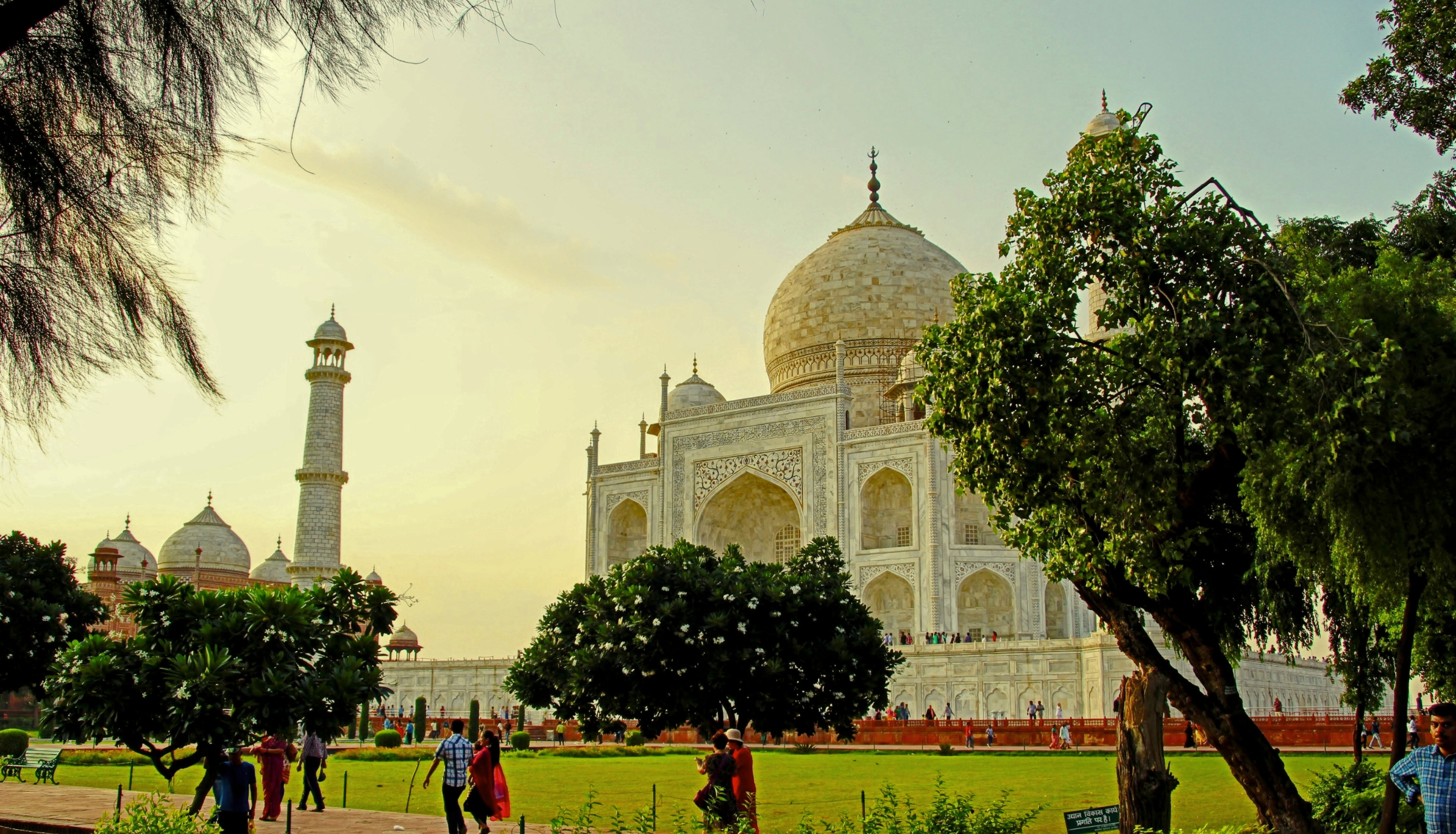Unveiling the Beauty of the Taj Mahal: Your Ultimate Visitor’s Guide
September 15, 2025

Your Complete Travel Guide to the Taj Mahal's Beauty
Some monuments still speak to us across time about love, devotion, art, and human creation. There is no other building like the Taj Mahal. This Agra marble masterpiece is more than simply a building; it's a symbol of eternal love and a once-in-a-lifetime experience for everyone who visits. It is one of the world's greatest wonders. This guide is your go-to resource for learning about the Taj Mahal since it mixes history, cultural significance, architectural splendor, traveler experiences, and helpful information.
While you're there, check out the Taj Mahal's museum and garden, the Taj Nature Walk.
A Story of Love and Loss
A love story inspired the Taj Mahal. Shah Jahan, the fifth Mughal emperor, loved his wife, Mumtaz Mahal, very much. She was his best friend, the mother of his children, and the one he trusted the most. The emperor was grieved when Mumtaz Mahal died in 1631 while giving birth to their fourteenth child.
In his sorrow, Shah Jahan swore to erect a monument that would honor her memory forever. There were years of planning and building that involved thousands of craftsmen, architects, and workers. The mosque, surrounding gardens, and other buildings were created in the years after the erection of the central mausoleum, which was finished about 1648. In addition to being a mausoleum, the Taj Mahal is a full work of art and symbolism that integrates Islamic, Indian, and Persian design elements.
The Taj became more than simply an architectural masterpiece as a result of this tale of dedication; it became a representation of love that still has an influence on people all around the world.
Initial Thoughts: The Entryway to Heaven
The trip normally starts at the magnificent red sandstone entrance archway as guests approach the Taj Mahal. This gateway acts as a figurative threshold, indicating the passage into heaven. The monument, framed like a painting at the end of the long water channel, is revealed in perfect symmetry as you travel through it.
Frequently, this "first look" moment is emotional. When the Taj Mahal appears before them, many tourists report experiencing wonder, serenity, and even tears. The monument looks to float due to the white marble's reflection in the water channel and the surrounding magnificent gardens.
The Gardens and Their Significance
The Taj Mahal complex was developed utilizing the standard charbagh layout, which is a four-part garden with water canals dividing it in the Persian manner. According to Islamic theology, this pattern symbolizes paradise as a garden with rivers of water, milk, wine, and honey.
Every step tourists take while meandering through the gardens displays symmetry. The eye is guided toward the center tomb by the gardens, fountains, and pathways. The grandeur of the marble edifice is counterbalanced by the quiet and serene environment provided by the gardens. In order to calmly observe how the Taj changes color with the movement of the sun, travelers generally advise spending some time reclining on the seats in the gardens.
The Magnificence of Architecture
The Taj Mahal's construction strikes the ideal harmony of elegance, accuracy, and purpose. Here are crucial things to observe:
- The Dome: The onion-shaped central dome, which rises to a height of around 35 meters, is crowned with a gilded finial. Four smaller domes on either side of it balance the composition. Particularly in the early morning or late evening sky, the dome seems to float weightlessly.
- The Minarets: The tomb is framed by four slim minarets that are tilted slightly outward. In order to prevent damage to the main structure in the case of an earthquake, the towers were purposely engineered to tilt away from it.
- Pietra Dura Inlay: Semi-precious stones like onyx, jade, and jasper are inlaid into the white marble walls to make complex floral motifs. Centuries later, the delicate designs made by this pietra dura process are still bright.
- Calligraphy: The mausoleum and doorway both have Quranic passages engraved in black marble. The calligraphy is so well-designed that, although the letters are larger at the top, they appear uniform in size when viewed from the ground.
- Play of Light: The Taj Mahal's marble is renowned for its ability to reflect light. It radiates a delicate pink at dawn, a bright white during the day, a golden color at sunset, and a silvery sheen when viewed by the moon.
Ideal Time to Go
The time of day you visit the Taj Mahal can make all the difference.
- Sunrise: The most lovely time is at sunrise. The gardens are quiet, the crowds are smaller, and the monument glows with brilliant colors. Many visitors report that the Taj's greatest spiritual experience happens around sunrise.
- Midday: The marble is most bright in the afternoon sun, but it is also the busiest time of day. Even while it might feel crowded, the monument's magnitude and magnificence are nonetheless stunning.
- Sunset: Photographers' favorite is the sunset. The Taj is bathed in golden hues when the sun sets, and the grounds look more serene than they would be during midday.
- Full Moon Nights: On particular evenings, tourists are permitted to glimpse the Taj Mahal beneath the moon. The monument sparkles in silvery light, giving it an ethereal look. Those who are fortunate enough to experience these remarkable evenings will never forget them.
The finest months are October through March, when the sky is clearer and the temperature is cooler. While the monsoon (July to September) brings rain and humidity, the summers (April to June) can be fairly hot. However, dramatic skies can occasionally create for spectacular images.
Reviews and Experiences of Travelers
Numerous tourists have recalled their experiences with the Taj Mahal over the ages. The following themes recur regularly in the experiences of travelers:
- Emotional Impact: A lot of travelers claim that their initial experience of the Taj is overpowering. Some say it's like walking into a painting, while others describe it as a dream come true.
- Crowd Control: Evaluations typically point out how the visit's time effects it. Early arrivals typically speak of a quiet and spiritual experience, while later visitors talk of crowds but are nonetheless strongly touched by the monument's magnificence.
- Attention to Detail: Instead of merely taking pictures of the broad horizon, tourists are recommended to spend some time analyzing the little aspects, such as the calligraphy panels, the delicate marble screens, and the inlaid flowers.
- Personal Thoughts: While history aficionados consider the Taj as a lesson in Mughal culture, couples typically view it as a romantic pilgrimage. Many people who travel alone characterize it as a quiet experience, a time to examine the themes of mortality and love.
Useful Advice for a Stress-Free Trip
- Entry and Tickets: To prevent lines, acquire your tickets in advance. East, West, and South are the three principal gates. For morning visits, the East Gate is frequently utilized.
- Security Guidelines: Food, bulky bags, and particular objects are prohibited inside. Keep only the necessities with you, such as your ID, camera, ticket, and water.
- Shoes: When entering the tomb, shoes may need to be covered or taken off. It is advisable to wear appropriate walking shoes when viewing the grounds and gardens.
- Guides: By highlighting specifics and sharing anecdotes you might overlook, a qualified guide can improve your vacation. Outside the gates, though, be wary of unofficial guides.
- Respectful Conduct: The Taj Mahal is a religious place as well as a famous tourist destination. Don't touch fragile objects, don't climb on structures, and speak quietly inside the mausoleum.
Examining Areas Other Than the Taj
The Taj Mahal's native city of Agra provides more:
- Agra Fort: Shah Jahan was later imprisoned at the Agra Fort, a massive red sandstone stronghold, by his son Aurangzeb. He could see the Taj Mahal on the other side of the river from his window.
- Mehtab Bagh: Across the Yamuna River, this garden complex affords one of the greatest views of the Taj Mahal at nightfall.
- Local Markets: Marble crafts, leather products, carpets, and confections are among the things that Agra is famous for. You may get a flavor of the city's customs and culture by browsing the bazaars.
An Ever-Evolving Monument
Time does not stand still around the Taj Mahal. It is still protected from the affects of aging, weather, and pollution by conservation initiatives. Scaffolding and restoration work are periodically apparent to visitors, but they are vital to assure the monument's existence for next generations.
By following the standards, reducing garbage, and demonstrating appreciation for the area, each visitor contributes to its preservation.
The Taj Mahal portrays a profound human story in marble and is more than just a marvel of design. Centuries after it was created, it still elicits wonder because it was conceived out of love, constructed with commitment, and maintained by generations of appreciation. A visit to the Taj blends history, art, and emotion in a way that no camera can truly express. It is more than merely watching a monument.
The Taj Mahal serves as a reminder of the beauty that love and creativity can bring into the world, whether you stand in silent awe before it at daybreak, watch it sparkle in the sunset sun, or take a leisurely stroll through its gardens. Every traveler regards it as more than just a destination to visit; it is a memory that will always be cherished.
